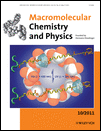Journal list menu
Export Citations
Download PDFs
Cover Picture
Macromol. Chem. Phys. 10/2011
- First Published: 13 May 2011

Front Cover: A side chain polyrotaxane with photoresponsive and nonresponsive recognition sites linked with a long linker is synthesized. The photoregulated switching of the position of the rotor, α-cyclodextrin, in the side chain polyrotaxane is realized. Further details can be found in the article by J. Hu, A. Hashidzume, and A. Harada* on page 1032.
Contents
Talents & Trends
Trends in Polymer Science
Externally Induced Thermal Actuation of Polymer Nanocomposites
- Pages: 992-998
- First Published: 05 April 2011

Thermally active polymers have attracted great attention because of the convenience and effectiveness of the thermal stimulation among the stimuli-responsive polymers. The trend article presents a brief overview of recent progress on externally induced thermal actuation of polymer nanocomposites, with emphasis on the influence of embedded nanomaterials which serve as “nanoantennas” and “nanoheaters” for harvesting and converting the external stimulus into thermal stimulation.
Full Paper
A Highly Efficient Iron-Mediated AGET ATRP of Methyl Methacrylate Using Fe(0) Powder as the Reducing Agent
- Pages: 999-1006
- First Published: 15 March 2011
Full Papers
A Simple Access to the (Log/Normal) Molecular Weight Distribution Parameters of Polymers Using PGSTE NMR
- Pages: 1007-1015
- First Published: 10 March 2011

It is demonstrated how PGSE NMR data can be used to derive MW and MWD of a polymer sample. The sensitivity and relative error of the method are discussed, and its applicability is illustrated by analyzing the experimental NMR response curve of three PEO samples. The method is shown to be simple, numerically robust, and reliable.
A Strategy for Fabrication of Columnar Supramolecular Polymers by Highly Directional π-π Stacking and Strong Multiple Ionic Bonds
- Pages: 1016-1021
- First Published: 07 March 2011

A strategy for the fabrication of columnar supramolecular polymer is provided by simple addition of two oppositely charged discotic conjugated monomers. Studies indicate that π-π interactions ensure a highly directional columnar stacking of monomeric units and make ions preferentially interact with the oppositely charged ion of the next layer. Conversely, forming multiple ionic bonds effectively promotes π stacking of building blocks and makes the column more stable.
Effect of Rotaxane Formation on the Photophysical, Morphological, and Adhesion Properties of Poly[2,7-(9,9-dioctylfluorene)-alt-(5,5'-bithiophene)] Main-Chain Polyrotaxanes
- Pages: 1022-1031
- First Published: 17 March 2011
![Effect of Rotaxane Formation on the Photophysical, Morphological, and Adhesion Properties of Poly[2,7-(9,9-dioctylfluorene)-alt-(5,5'-bithiophene)] Main-Chain Polyrotaxanes](/cms/asset/73ae7c5b-a476-44fc-9f27-0f902810a3eb/mcontent.jpg)
The formation of a rotaxane architecture modifies the optoelectronic, morphological, and adhesion properties of fluorene/bithiophene copolymers. This shows that either rotaxane formation causes no deaggregating effect on the copolymers or that the rotaxane copolymer is not prone to aggregation in both solution and thin films. Rotaxane formation leads to improved thermal stability and a blue shift in absorption.
Photoregulated Switching of the Recognition Site of α-Cyclodextrin in a Side Chain Polyrotaxane Bearing Two Recognition Sites Linked with Oligo(ethylene glycol)
- Pages: 1032-1038
- First Published: 30 March 2011
Nanostructured Interpenetrating Polymer Network (IPN) Precursor Ultrathin Films
- Pages: 1039-1049
- First Published: 31 March 2011

The electropolymerization of a nanostructured layer-by-layer (LbL) film enables interpenetrating polymer network (IPN) formation in a very quantitative manner. Oppositely charged polyelectrolyte precursors facilitate formation of IPN of π-conjugated polymers or simply conjugated polymer network (CPN) films by electropolymerization. UV–Vis absorption spectroscopy, QCM, ellipsometry, EIS, and AFM are used to characterize the films.
1,2,3-Triazole-Incorporated Diacrylate Monomer for Free Radical Cyclopolymerization Through Large Ring Formation
- Pages: 1050-1055
- First Published: 31 March 2011

A new 1,2,3-triazole incorporated diacrylate monomer is designed for free radical cyclopolymerization through the formation of eleven-membered rings. Structural analysis of the cyclopolymers based on NMR analysis including 1H, 13C, DEPT-135, and 1H–13C HMQC spectra supports a high degree of cyclization. GPC profiles of the cyclopolymers show unimodal distributions indicative of no chain branching reactions.
Backbone-Thermoresponsive Hyperbranched Polyglycerol by Random Copolymerization of Glycidol and 3-Methyl-3-(hydroxymethyl)oxetane
- Pages: 1056-1062
- First Published: 05 April 2011

Backbone-thermoresponsive hyperbranched poly[glycerol- co-3-methyl-3- (hydroxymethyl)oxetane] with low cytotoxicity is synthesized by one-step random copolymerization of glycidol and 3-methyl-3-(hydroxymethyl)oxetane (MHO). LCST is readily adjusted by changing the feed ratio of glycidol to MHO. This novel, thermoresponsive hyperbranched polyglycerol is a promising functional material for biomedical applications.
Phase-Separation Kinetics and Mechanism in a Methylcellulose/Salt Aqueous Solution Studied by Time-Resolved Small-Angle Light Scattering (SALS)
- Pages: 1063-1071
- First Published: 31 March 2011

The phase-separation kinetics and mechanism of aqueous MC solutions in the presence of 5% NaCl are discussed. The scattering peak shows that phase separation occurs by spinodal decomposition. The spinodal temperature is determined using CHC theory. In the late stage of phase separation, the dynamic structural factor collapses into a universally time-independent curve.
Free Radical Polymerization Kinetics of Vinylsulfonic Acid and Highly Acidic Properties of its Polymer
- Pages: 1072-1079
- First Published: 29 March 2011

Poly(vinylsulfonic acid) (PVS) has a high acid density (IEC=9.2 meq·g−1) and is the solid-state organic analog of sulfuric acid. Radical polymerization of the acid form of vinylsulfonic acid is kinetically investigated. PVS with a high molecular weight is obtained as a transparent membrane and shows a high proton-conductivity under both hydrated and nonhumidified conditions.
Stimuli Responsive Size Control of Hyperbranched Polymers
- Pages: 1080-1085
- First Published: 05 April 2011

Polymer systems exhibiting a wide range of mean coil size are presented. These multivalent polymers of hyperbranched polyethylenimine (PEI) covalently attached to cyclodextrin (CD) are synthesized and characterized. Different spacer lengths and its influence on the agglomeration behavior are demonstrated.








